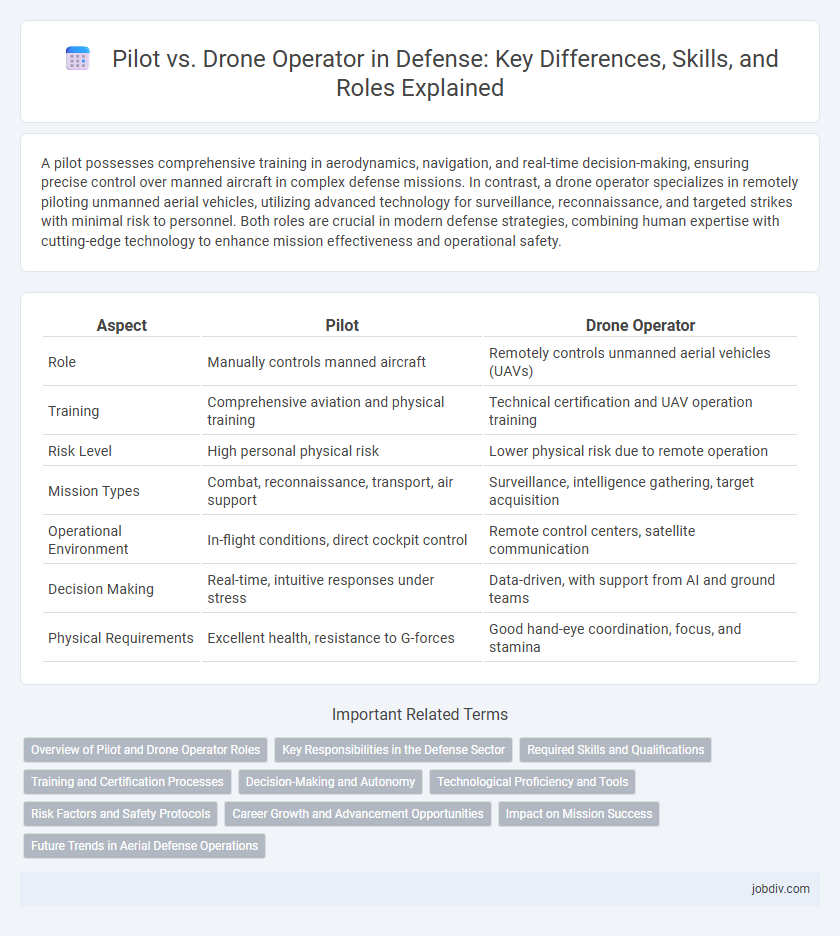A pilot possesses comprehensive training in aerodynamics, navigation, and real-time decision-making, ensuring precise control over manned aircraft in complex defense missions. In contrast, a drone operator specializes in remotely piloting unmanned aerial vehicles, utilizing advanced technology for surveillance, reconnaissance, and targeted strikes with minimal risk to personnel. Both roles are crucial in modern defense strategies, combining human expertise with cutting-edge technology to enhance mission effectiveness and operational safety.
Table of Comparison
| Aspect | Pilot | Drone Operator |
|---|---|---|
| Role | Manually controls manned aircraft | Remotely controls unmanned aerial vehicles (UAVs) |
| Training | Comprehensive aviation and physical training | Technical certification and UAV operation training |
| Risk Level | High personal physical risk | Lower physical risk due to remote operation |
| Mission Types | Combat, reconnaissance, transport, air support | Surveillance, intelligence gathering, target acquisition |
| Operational Environment | In-flight conditions, direct cockpit control | Remote control centers, satellite communication |
| Decision Making | Real-time, intuitive responses under stress | Data-driven, with support from AI and ground teams |
| Physical Requirements | Excellent health, resistance to G-forces | Good hand-eye coordination, focus, and stamina |
Overview of Pilot and Drone Operator Roles
Pilots operate manned aircraft, relying on physical control and direct visual observation to execute missions, often requiring extensive flight training and certification. Drone operators manage unmanned aerial vehicles (UAVs) remotely, utilizing advanced control interfaces and real-time data feedback to conduct surveillance, reconnaissance, or targeted strikes. Both roles demand specialized skills in navigation and situational awareness but differ significantly in operational environment and technology use.
Key Responsibilities in the Defense Sector
Pilots in the defense sector are responsible for operating manned aircraft during combat missions, reconnaissance, and transport, ensuring mission success through skilled maneuvering and real-time decision-making under high-pressure conditions. Drone operators control unmanned aerial vehicles (UAVs) for surveillance, target acquisition, and precision strikes, relying heavily on remote piloting technology and real-time data analysis. Both roles require a deep understanding of military tactics, communication protocols, and rapid response to evolving battlefield scenarios to support strategic defense objectives.
Required Skills and Qualifications
Pilot roles demand advanced flight training, strong situational awareness, and physical endurance to manage complex aircraft controls and emergency scenarios. Drone operators require proficiency in remote piloting systems, real-time data analysis, and cybersecurity knowledge to effectively navigate unmanned aerial vehicles and ensure mission success. Both positions need specialized certifications, with pilots often certified by aviation authorities and drone operators trained in specific drone technologies and regulatory compliance.
Training and Certification Processes
Pilot training involves extensive flight hours, simulator sessions, and certification from aviation authorities such as the FAA, emphasizing manual control skills and situational awareness. Drone operators undergo specialized training programs covering remote control systems, payload management, and regulatory compliance, often certified by organizations like the AUVSI. Both roles require rigorous assessments, but pilot certification demands broader aeronautical knowledge while drone operator credentials focus on remote piloting protocols and cybersecurity.
Decision-Making and Autonomy
Pilot decision-making relies heavily on real-time sensory input, situational awareness, and human intuition to adapt to unpredictable combat environments. Drone operators depend on autonomous systems integrated with AI algorithms that enable rapid data processing and mission execution with minimal human intervention. Advances in autonomous technology enhance drone operational efficiency while pilots maintain a critical advantage in complex judgment scenarios requiring ethical and strategic considerations.
Technological Proficiency and Tools
Pilots demonstrate advanced technological proficiency through direct control of complex aircraft systems, integrating flight instruments, navigation tools, and real-time decision-making in dynamic environments. Drone operators utilize sophisticated remote-control interfaces, sensor arrays, and software platforms enabling precise mission execution and real-time data analysis from unmanned aerial vehicles (UAVs). The evolving defense landscape demands both roles maintain expertise in emerging technologies such as autonomous flight algorithms, cybersecurity protocols, and augmented reality systems to enhance operational effectiveness.
Risk Factors and Safety Protocols
Pilot risk factors include physical strain from prolonged flights and exposure to high-G maneuvers, while drone operators face cybersecurity threats and remote sensory limitations. Safety protocols for pilots emphasize rigorous pre-flight checks and in-flight situational awareness training, whereas drone operators rely on robust communication encryption and real-time monitoring to mitigate data breaches and signal loss. Both roles require strict adherence to standardized emergency procedures to manage malfunctions and ensure mission success.
Career Growth and Advancement Opportunities
Pilot careers in defense offer structured advancement through rank promotions and specialized training, leading to command positions and strategic roles. Drone operators experience rapid career growth driven by technological innovation and increasing reliance on unmanned systems, with opportunities in cyber operations, intelligence analysis, and mission planning. Both paths provide specialized skill development, but pilots often have broader leadership prospects while drone operators advance through technical expertise and emerging warfare domains.
Impact on Mission Success
Pilot expertise directly influences mission success through real-time decision-making, situational awareness, and adaptive response to dynamic combat environments. Drone operators rely on remote sensory data and communication links, which may introduce latency and limit immediate tactical adjustments, potentially affecting operational effectiveness. The integration of skilled pilots and drone operators enhances mission outcomes by combining human intuition with advanced technological surveillance capabilities.
Future Trends in Aerial Defense Operations
Pilot roles will increasingly integrate with drone operators to enhance situational awareness and mission effectiveness in aerial defense operations. Autonomous drone swarms equipped with AI-driven threat detection are set to complement manned aircraft, reducing pilot workload and expanding operational capabilities. Advanced human-machine interfaces, including augmented reality helmets, will enable seamless collaboration between pilots and drone operators for real-time strategic decision-making.
Pilot vs Drone Operator Infographic

 jobdiv.com
jobdiv.com